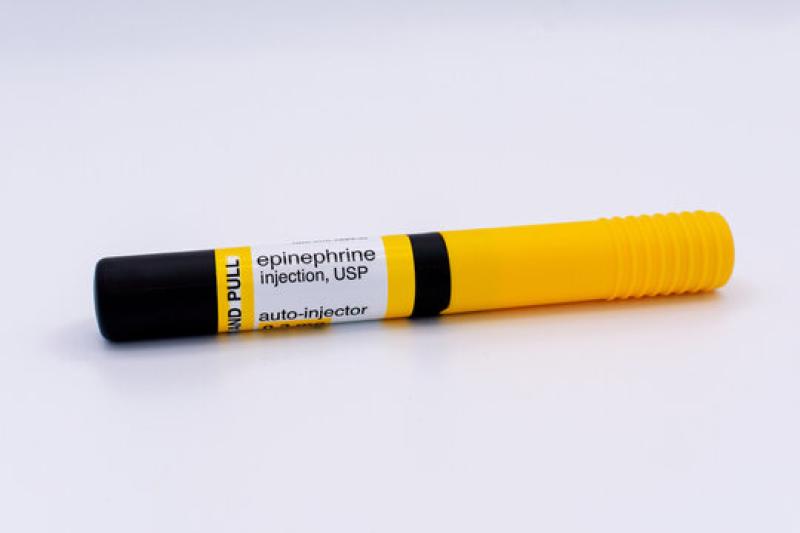What is Epinephrine?
The hormone epinephrine, also known as adrenaline, plays a crucial role in our body's fight-or-flight response. It is produced by the medulla of the adrenal glands located above the kidneys. When our body perceives a threat or stressful situation, the adrenal glands release it into the bloodstream to help prepare our body to respond quickly.
The Synthesis and Release
It is synthesized in the adrenal medulla from the amino acids phenylalanine and tyrosine. This process involves four main steps:
1. Tyrosine hydroxylase converts tyrosine to L-DOPA (levodopa).
2. Aromatic L-amino acid decarboxylase converts L-DOPA to dopamine.
3. Dopamine beta-hydroxylase converts dopamine to norepinephrine.
4. Phenylethanolamine N-methyltransferase converts norepinephrine to epinephrine.
When our sympathetic nervous system senses a threat or stressor, it signals the adrenal medulla to release it into circulation. Epinephrine levels in the blood rise rapidly within seconds and remain elevated for several minutes to help mobilize our body's resources.
The Effects in the Body
Once released into the bloodstream, it binds to adrenergic receptors located throughout the body to induce several physiological changes that prepare our body for fighting threats or fleeing from danger. The key effects of it include:
- Increased heart rate and force of heartbeat: Binding of it to beta1 receptors in the heart increases heart rate, contractility, and cardiac output to deliver more oxygen to muscles.
- Dilated pupils: Its binding to alpha1 receptors in the iris dilates the pupils to maximize visual input and focus during a crisis situation.
- Increased blood flow to muscles: Vasodilation of blood vessels in skeletal muscles and brain increases delivery of glucose and oxygen via binding to beta2 receptors. Nonessential functions like digestion are conserved.
- Increased blood glucose: Glucagon and epinephrine signal breakdown of glycogen to glucose in the liver, and lipolysis of fats, raising blood sugar levels available as instant fuel.
- Increased respiration rate: Binding of it to beta2 receptors on bronchioles in lungs opens airways and increases tidal volume and respiration rate.
- Increased breakdown of fats and protein: It stimulates lipolysis of fats and proteolysis of proteins via binding to beta2 receptors on adipocytes and liver cells.
- Increased blood pressure: It causes vasoconstriction by binding to alpha1 receptors, raising blood pressure to circulate more blood to muscles while conserving blood volume.
- Increased mental alertness: Epinephrine released in the brainstem and cerebral cortex enhances arousability, focus, motivation, and vigilance.
Role in Stress and Pathologies
Under acute stress or threat, the surge of it prepares our body optimally for fight-or-flight by mobilizing the optimal blend of physiological changes. However, chronic overactivation of the stress response can negatively impact health over the long run. Repeated elevations in cortisol and epinephrine due to sustained stress have been linked to increased risks of high blood pressure, cardiovascular disease, anxiety, depression, digestive issues, and impaired immunity from the wear and tear on regulatory systems. It dysregulation also plays a role in stress-related disorders like panic attacks. Precision testing and intervention can help address dysfunctional stress responses at pharmacological and lifestyle levels.
The Medical Uses
Due to its potent and rapid physiological effects, it has critical medical applications beyond its natural fight-or-flight role. Epinephrine autoinjectors known by brand names like EpiPen are prescribed to treat life-threatening allergic reactions or anaphylaxis. A single intramuscular injection delivers a standardized dose to rapidly counteract constriction of airways and loss of blood pressure through its effects on vascular dilation and bronchial smooth muscle. It is also commonly used during medical emergencies to reverse cardiac arrest and stabilize irregular heartbeats by increasing heart rate and contractility. As an injectable drug in hospitals, controlled dosing is crucial for procedures like bronchial asthma treatments and cardiac diagnostic tests due to its potent cardiovascular and respiratory impacts.
Get More Insights on Epinephrine
Identify the language that you favour-
About Author-
Vaagisha brings over three years of expertise as a content editor in the market research domain. Originally a creative writer, she discovered her passion for editing, combining her flair for writing with a meticulous eye for detail. Her ability to craft and refine compelling content makes her an invaluable asset in delivering polished and engaging write-ups.
(LinkedIn: https://www.linkedin.com/in/vaagisha-singh-8080b91)
